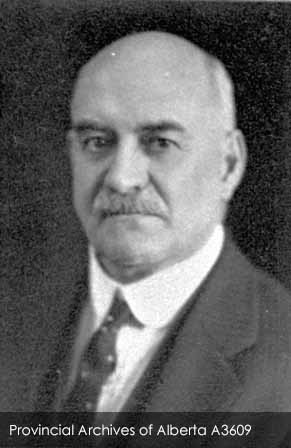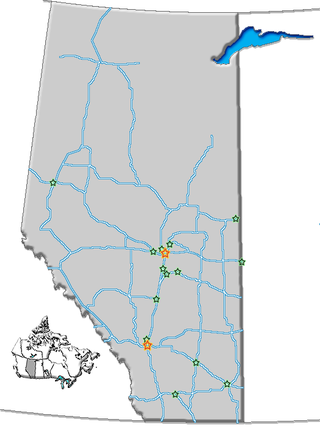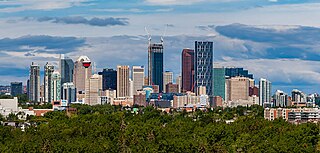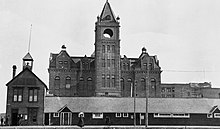
Wetaskiwin is a city in the province of Alberta, Canada. The city is located 70 kilometres (43 mi) south of the provincial capital of Edmonton. The city name comes from the Cree word wītaskiwinihk, meaning "the hills where peace was made".
The Southern Alberta Institute of Technology (SAIT) is a polytechnic institute in Calgary, Alberta, Canada. SAIT offers more than 110 career programs in technology, trades and business. Established in 1916, it is Calgary's second oldest post-secondary institution and Canada's first publicly funded technical institute.

Fort Calgary was a North-West Mounted Police outpost at the confluence of the Bow and Elbow rivers in present-day Calgary, Alberta, Canada. Originally named Fort Brisebois, after the outpost's first commander, the outpost was renamed Fort Calgary in June 1876.

The Old City Hall is a Romanesque-style civic building and former court house in Toronto, Ontario, Canada. It was the home of the Toronto City Council from 1899 to 1966 and a provincial court house until 2023, and remains one of the city's most prominent structures.

Mewata Armoury is a Canadian Forces reserve armoury in Calgary, Alberta, Canada. Mewata ( is derived from the Cree word ᒥᔭᐋᐧᑕᒼ, meaning "Oh, be joyful".

Stephen Avenue is a major pedestrian mall in downtown Calgary, Alberta, Canada. The mall is the portion of 8 Avenue SW between 4 Street SW and 1 Street SE. It is open to vehicles only from 6:00 p.m. to 6:00 a.m.

John Irwin Sr. was a Canadian provincial politician from Alberta. He served as a member of the Legislative Assembly of Alberta from 1926 to 1940 sitting with the Conservative caucus in opposition.

The Alberta Aviation Museum is an aviation museum located in Edmonton, Alberta, Canada. The museum is located on-site at the former Edmonton City Centre Airport on the southwest corner of the field.

Rutherford House is a historic building and museum in the Strathcona area of Edmonton, Alberta, Canada. The structure was the home of the first Premier of Alberta, Alexander Cameron Rutherford, from 1911 to 1941, and has subsequently been designated as an Alberta provincial historic site.

Provincial historic sites of Alberta are museums and historic sites run by the Government of Alberta.

Calgary is the largest city in the Canadian province of Alberta. It is the largest metro area within the three Prairie Provinces region. As of 2021, the city proper had a population of 1,306,784 and a metropolitan population of 1,481,806, making it the third-largest city and fifth-largest metropolitan area in Canada.
Heritage buildings in Edmonton, as elsewhere in Canada, may be designated by any of the three levels of government: the Government of Canada, the Government of Alberta, or the City of Edmonton.

The Calgary Fire of 1886, also known as the Great Calgary Fire of 1886, was a conflagration that burned in the Canadian city of Calgary on Sunday November 7, 1886. The fire began at the rear wall of the local flour and feed store, and spread through the community's wooden structures leading to the destruction of 18 buildings.

The Paskapoo Formation is a stratigraphic unit of Middle to Late Paleocene age in the Western Canada Sedimentary Basin. The Paskapoo underlies much of southwestern Alberta, and takes the name from the Blindman River. It was first described from outcrops along that river, near its confluence with the Red Deer River north of the city of Red Deer, by Joseph Tyrrell in 1887. It is important for its freshwater aquifers, its coal resources, and its fossil record, as well as having been the source of sandstone for the construction of fire-resistant buildings in Calgary during the early 1900s.

Lougheed House, or as it was originally known Beaulieu, is a National Historic Site located in the Beltline district of Calgary, Alberta. Originally constructed in 1891 as a home for Senator James Alexander Lougheed KCMG PC KC and his wife Isabella Clarke Hardisty, the structure has since become an iconic heritage building in Calgary. Lougheed House is operated by Lougheed House Conservation Society, an independent, non-profit society devoted to the restoration and public enjoyment of the historic house and its Gardens.

Naheed Kurban Nenshi is a Canadian politician who was the 36th mayor of Calgary, Alberta. He was elected in the 2010 municipal election with 39% of the vote, and is the first Muslim mayor of a large North American city. He was re-elected in 2013 with 74% of the vote and again re-elected in 2017 to a third term with 51% of the vote. After serving three terms as mayor, he did not seek re-election in the 2021 Calgary municipal election, and was succeeded by Jyoti Gondek. On March 11, 2024, Nenshi announced his candidacy for the leadership of the Alberta New Democratic Party.
In Canada, heritage conservation deals with actions or processes that are aimed at safeguarding the character-defining elements of a cultural resource so as to retain its heritage value and extend its physical life. Historic objects in Canada may be granted special designation by any of the three levels of government: the federal government, the provincial governments, or a municipal government. The Heritage Canada Foundation acts as Canada's lead advocacy organization for heritage buildings and landscapes.
The Paskapoo Slopes are a significant natural, environmental and cultural feature on the western side of Calgary, Alberta. They have a high visual impact and are a prominent landmark along the Trans Canada Highway, Calgary's western gateway from the Rockies.

The Calgary Municipal Building, often referred to as New City Hall is the seat of local government for the city of Calgary, Alberta, Canada. The building has been the centre for civic administration for the City of Calgary since it opened in 1985 to consolidate city administration, provide council chambers, and complement old Calgary City Hall, which is used as the offices of the mayor and councillors.

The 1913 Calgary municipal election took place on December 8, 1913 to elect a Mayor and twelve Aldermen to sit on the twenty-ninth Calgary City Council from January 2, 1914 to January 2, 1915. Additionally a Commissioner, two trustees for the Public School Board, three trustees for the Separate School Board, two bylaws regarding the term and remuneration of Aldermen and a plebislicte on whether to donate the Mewata Park to the Dominion Government for the site of the Mewata Armouries was included on the ballot.




















